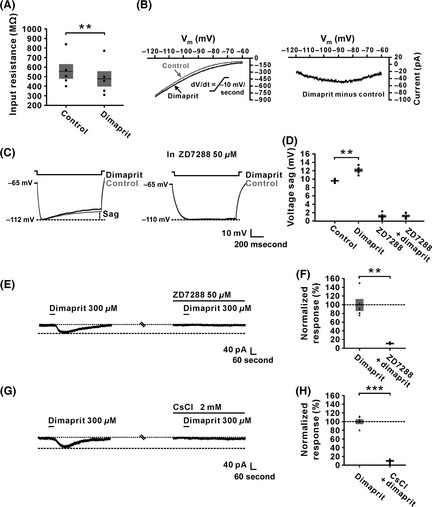Figure 5.

Hyperpolarization‐activated cyclic nucleotide‐gated channels were responsible for the inward current induced by the activation of H2 receptors on inferior vestibular nucleus (IVN) neurons. (A) Application of dimaprit (300 μM), a highly selective H2 receptor agonist, decreased the membrane resistance of recorded IVN neurons (n = 5, P = 0.0089). (B) The dimaprit‐induced changes of I–V curves (the left panel) and the difference current representing the current induced by the activation of H2 receptors (the right panel) in slow‐ramp command tests (dV/dt = −10 mV/s) showing a significant hyperpolarization activation feature of the current of HCN channels. (C) Inward rectification (sag) triggered by hyperpolarizing current steps on an IVN neuron was increased by dimaprit (300 μM) (the left panel). ZD7288 (50 μM), a highly selective HCN channel antagonist, totally blocked the increase in the sag induced by dimaprit (the right panel). (D) Group data of the tested IVN neurons (n = 5, P = 0.0062). (E and F) ZD7288 totally blocked the dimaprit‐induced inward current (n = 5, P = 0.0013). (G and H) CsCl, another antagonist of HCN channels, also totally blocked dimaprit‐induced inward current (n = 5, P = 0.0002). Data shown are means ± SEM; **P < 0.01, ***P < 0.001.
